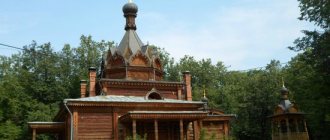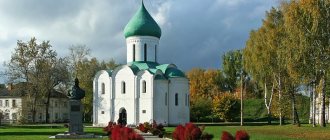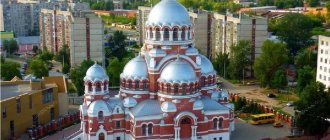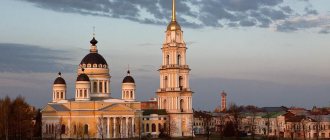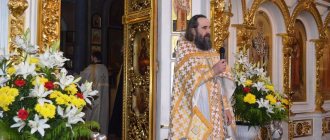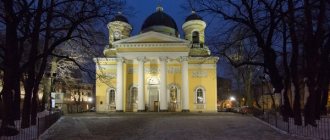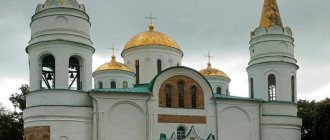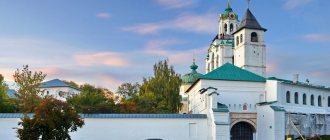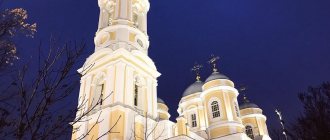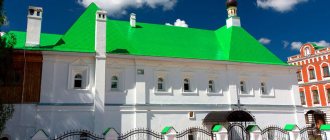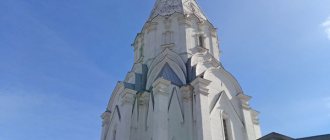This term has other meanings, see Transfiguration Cathedral.
| Cathedral | |
| Transfiguration Cathedral | |
| 50°35′54″ n. w. 36°35′18″ E. d.HGЯOL | |
| A country | Russia |
| Location | Belgorod, Preobrazhenskaya st. 63-B |
| Confession | Russian Orthodox Church |
| Diocese | Belgorodskaya and Starooskolskaya |
| Deanery | I Belgorodskoe |
| Architectural style | Russian classicism |
| Author of the project | Evgeniy Alekseevich Vasiliev |
| Construction | 1807-1813 |
| Status | OKN No. 3100023000 No. 3100023000 |
| Website | belfavor.ru |
| Media files on Wikimedia Commons | |
Transfiguration Cathedral
- Cathedral of the Belgorod diocese, located in Belgorod.
Wooden Transfiguration Church
The predecessor of the current Transfiguration Cathedral in Belgorod was a wooden church, consecrated in honor of the great church holiday, the Transfiguration of the Lord. According to researchers, it was located on the territory of the Old City, called the Nogai side, as evidenced by entries in the Scribe books, the earliest of which dates back to 1626.
From the same source it is known that her clergyman owned very extensive land plots located on the opposite bank of the Seversky Donets. He owned not only arable plots, but also rich fishing grounds. This church survived even after in 1646, due to the construction of new defensive structures, the city was moved to the right bank of the Seversky Donets.
Moscow Patriarchate Belgorod Metropolitanate
With the blessing of His Eminence John, Metropolitan of Belgorod and Stary Oskol
The Ladder Theater presented a new work, “Mother’s Cross,” for the 75th anniversary of the Great Victory
The Ladder Theater showed a new work - the play "Mother's Cross" about the front-line fate of a resident of Belgorod.
On the Feast of the Transfiguration of the Lord, hundreds of Belgorod residents united in prayer
On the day of the patronal feast of the Transfiguration of the Lord, the Divine Liturgy was performed by Metropolitan John of Belgorod and Stary Oskol. At the end of the Liturgy, a religious procession took place with the relics of St. Joasaph of Belgorod.
Certificates of completion of three-year theological courses were received by students of the Sisters of Mercy Department of the Medical College of the BelSU National Research University.
15 students completed 3-year theological courses and received initial theological education.
“Legends of Vardzia” - the premiere of the play about Queen Tamara took place
The Ladder Theater delighted the audience with the premiere of “The Legend of Vardzia,” which tells the story of the life of the holy Georgian queen Tamara.
Cathedral clergy received liturgical and hierarchical awards for Easter
Archpriest Anatoly Triger was awarded the right to serve the Divine Liturgy with the Royal Doors open according to “Izhe Cherubim. » inclusive. Archpriest Georgy Vlasenko was awarded the right to wear a cross with decorations
Good initiative
Not far from it there was another, also wooden, St. Elias Church. When by the beginning of the 19th century both of them were very dilapidated and were subject to demolition, on the initiative of the local mayor I.P. Leontyev, it was decided to build one stone one instead of two wooden churches. He chose a suitable location for the future construction on Bazarnaya Square, not far from Kurskaya Street, which today bears the name of Popov. This is how the idea of creating the Transfiguration Cathedral in Belgorod was born.
Any good undertaking, and especially such a grandiose one as the construction of God’s temple, requires a material base. In this regard, a fundraiser was announced, in which all residents of the area took part. As has been the custom in Rus' since ancient times, along with representatives of the wealthy strata of the population ─ the nobility and merchants, donations were made for charitable causes even by those who had to sacrifice their last penny for this.
Nearest temples, churches and monasteries in Belgorod
The distance is indicated from [name] at the address Belgorod region, Belgorod, Preobrazhenskaya street, 46.
| Distance | Address |
| 448 m. | Belgorod, Belgorodsky prospect, 50 |
| 548 m. | Russia, Belgorod region, Belgorod, Holy Trinity Boulevard, 24 |
| 566 m. | Belgorod, Civil Avenue, 50 |
Temple-monument
When, finally, the necessary amount was collected, they became concerned with creating a project for the future cathedral, the work on which was entrusted to the Kharkov architect Evgeniy Alekseevich Vasiliev. Although he was young, he was already a well-established architect. Suffice it to say that at one time the future creator of the Transfiguration Cathedral in Belgorod learned the secrets of craftsmanship in a workshop led by the best St. Petersburg teacher D. Kvarneghi, the author of many sensational projects at that time.
Since the construction and decoration of the Transfiguration Cathedral (address: Belgorod, Preobrazhenskaya St., 63-B) was completed in 1813, it was decided to dedicate it to Russia’s victory over the Napoleonic army. The tradition of erecting monumental churches has a long history in our country, and therefore such a patriotic idea was met with universal approval.
Throughout the 19th and early 20th centuries, the Transfiguration Cathedral, although not a cathedral, was one of the first in the city in terms of the number of parishioners. A two-year parochial school was constantly operating under him, as well as several educational workshops, in which children from the poorest families could gain skills in some crafts. It is characteristic that, according to documents preserved in the city archive, the cathedral clergy did not receive a salary from the diocesan authorities, and for its maintenance had some auxiliary trades, including trading shops that were rented out.
Temples of the Belgorod region City of Belgorod
Transfiguration Cathedral
Address:
308000, Belgorod, st. Preobrazhenskaya, 63-V. Phone: , 32-44-06, 33-68-25. Rector: Archpriest Oleg Nikolaevich Kobets. The clergy of the temple: Archpriest Nikolai Gerasimovich Kobets, Archpriest Boris Vladimirovich Lavrushin, Archpriest Viktor Ivanovich Kravets, Archpriest Viktor Aleksandrovich Tolstikov, Priest Alexy Sergeevich Kurenkov, Priest Dimitry Vladimirovich Karpenko, Priest Andrei Igorevich Khvylya-Olinter, Protodeacon Igor Evgenievich Pankratov, di Akon Vladimir Olegovich Timofeev, Deacon Alexy Alexandrovich Makhonin.
The Church of the Transfiguration of the Lord was built at the expense of parishioners on the site of a dilapidated wooden church in 1813. Architect - Evgeny Alekseevich Vasiliev. (According to his designs, the university temple and the bell tower of the Assumption Cathedral in Kharkov were erected). At the beginning of the 20th century, the parish of the temple numbered 186 townspeople. There was a two-class parochial school at the temple. At the end of the 20s of the XX century, after the closure of the Holy Trinity Cathedral, the Transfiguration Church received the status of a cathedral. But in 1962, it was also among the temples subject to closure. The temple building was transferred to the regional museum of local lore.
In 1990, Divine services began in the Ilyinsky chapel. The cathedral was completely returned to the Church in July 1991.
In September 1991, the relics of St. Joasaph, Bishop of Belgorod, wonderworker (1705-1754), were transferred to the Transfiguration Cathedral, which today are the main shrine of the Belgorod and Stary Oskol diocese. On September 17, 1911, according to the Decree of the Holy Synod, approved by Emperor Nicholas II, Bishop Joasaph was glorified as a saint and his miraculous relics were found. Until December 1920, the holy relics rested in the Holy Trinity Cathedral in the city of Belgorod. At this time, they were opened by the Bolsheviks and sent first to Kursk for several months, then to Moscow, to the People's Commissariat of Land Museum.
But it became “dangerous” to leave the incorrupt relics of St. Joasaph of Belgorod in Moscow. Crowds of pilgrims came to them to venerate. The relics were urgently taken to Leningrad, to the Kazan Cathedral. (At that time the cathedral housed a museum of religion and atheism). At first, they tried to display the relics in the northern aisle of the cathedral - opposite the grave of M.I. Kutuzova. But then Moscow history repeated itself exactly. In 1970, the director of the Leningrad Museum of Religion and Atheism received instructions to remove the existing relics from the museum. But the museum workers Arkady Vasilyevich Sokolov and Vladimir Ivanovich Prudnikov decided to hide the relics of St. Joasaph in the attic of the Kazan Cathedral.
They kept this fact in the strictest confidence for more than twenty years. And only in 1991 the secret was revealed by Arkady Vasilyevich to his daughter. In the same year, the newly acquired relics, after identification, were brought to Moscow, where they were kept in the Patriarchal Epiphany Cathedral until September. Then the reliquary with the incorruptible relics was transported to Kursk. And exactly eighty years after the canonization of the Belgorod saint by the Orthodox Church, his relics returned to his throne city.
Since the mid-1990s. a new pious tradition has been established in the diocese: annually on August 19, on the feast of the Transfiguration of the Lord, the relics of St. Joasaph are transferred in a procession from the Transfiguration Cathedral to the St. Nicholas Cathedral, where they remain until September 16, when, after Little Vespers with an akathist, they are transferred in a procession to the Transfiguration Cathedral Cathedral. An all-night vigil is held there. On September 17, the day of glorification (1911) and the second discovery of the relics of the saint, three Divine Liturgies are celebrated in the cathedral on three altars (at 3 a.m., 6 a.m. and 9 a.m. - by the bishop's service) and a prayer service at the relics of the saint. An all-night vigil, three Divine Liturgies and a prayer service are celebrated in the cathedral also on December 23, the day of the saint’s repose (1754).
See also: Borovsk Cathedral
A particularly revered shrine of the Transfiguration Cathedral was the miraculous icon of St. Nicholas, called “Nicholas the Ratny,” which is more than 500 years old. According to legend, she protected the residents of the Shebekin village of Ustinka from an attack by Mongol-Tatar troops. Seeing the enemy, the inhabitants of the Nicholas Hermitage, located in the village, came out to meet him with an icon of St. Nicholas the Wonderworker. The Tatars crossing the river, seeing the religious procession, stopped, began to crowd together and fall from the dam into the water. The rest of the army turned back. There was a story about the case of a bloodless, unprecedented victory in every pre-revolutionary edition of the reference book “Orthodox Shrines”. Currently, every year in May, a procession of the cross from Belgorod to the village of Ustinka is carried out with the icon of “Nicholas the Ratnoy”.
Another shrine of the Transfiguration Cathedral is the icon of the Mother of God “The Sign”. This icon was made at the beginning of the 20th century. The icon was presented as a museum exhibit at an exhibition dedicated to the life and works of St. Joasaph. On one of the days of the exhibition, museum staff noticed that the faces of the Mother of God and the Infant were becoming brighter. The museum’s management decided to transfer the unusual icon to the Transfiguration Cathedral. This happened in early December 1998. The cathedral is an architectural monument built in the style of Russian classicism. One of two five-domed churches preserved in Belgorod.
History of the cathedral
By the end of the 19th century, an architectural style imitating Russian buildings came into fashion. The architecture of the 17th century, interrupted by the reforms of Peter I, was very popular and was considered the pinnacle of national talent and spirituality. Architects saw the works of old masters as the main source of creative inspiration and constantly sought to reproduce in their projects individual elements of ancient Russian buildings, ancient engineering solutions and rich decoration. A clear revival of pre-Petrine architecture at the end of the 19th century took place not only in large cities, but also in the Russian provinces.
Transfiguration Cathedral from a bird's eye view
Construction of the new Transfiguration Church began at the end of August 1889. The sponsor of the expensive construction was the wealthy Ivanovo manufacturer Methodius Nikonovich Garelin, the owner of a large textile manufactory.
And the design of the temple was prepared by the famous architect Alexander Stepanovich Kaminsky.
In Moscow,
he was a recognized master of the “late eclecticism” style and also became famous for the creation of the first building of the Tretyakov Gallery and the main temple in the Nikolo-Ugreshsky Monastery.
The new stone church took four years to build and was consecrated at the end of August 1993. Three chapels were created in it. In the main one, a majestic three-tiered iconostasis was installed, and in the side ones, dedicated to the Iveron Icon of the Mother of God and the Venerable Martyr Nikon, there were smaller iconostases, in two tiers. The drawings from which the master carvers made these iconostases were also prepared by the architect A.S. Kaminsky. And the icons for the church were painted by the famous master from Moscow Ya.I. Ruchkin. In addition, the Garelin family donated ancient icons to the temple, which were kept in their family chapel. The walls inside the building were commissioned to be painted by the icon painter I.V. Belousov. Later, the ktitor and his wife were buried with honor in the courtyard of the temple, opposite the church altar.
General view of the Transfiguration Cathedral from Kolotilova Street
The new temple was intended for residents of the village of Rylikha, located on the outskirts of the city of Ivanovo-Voznesensk and known from scribe books from the 17th century. When the church was built, the village received the status of a village and was renamed Preobrazhenskoye. This settlement became part of Ivanovo in February 1917.
In the early 30s of the last century, there were many conflicts around the temple, caused by the fact that the authorities allowed two parish communities to use this church at once - the traditional one and the Renovationist community. To prevent the situation from worsening, in 1940 the local authorities closed the temple to believers and destroyed its interior decoration. After this, not a single functioning church remained in the regional center. This went on for almost five years.
Holy Gate
In 1944, the townspeople turned to the state with a request to open the temple, and church services there resumed. However, this was not done immediately, but only in January 1945, since the church premises were in extremely disrepair.
In 1946, when the local diocese was formed, the Transfiguration Church received the status of a cathedral, and its side chapels were reconsecrated in honor of the icon of Our Lady of Kazan and St. Nicholas the Wonderworker. For the next 45 years, the White Church was the only functioning Orthodox church in the regional center. Of course, one relatively small church was not enough for Ivanovo, because about 480 thousand people lived in the city.
Restoration work in the temple began to be carried out when the Great Patriotic War ended. Gradually the paintings on its walls were renewed and the necessary liturgical utensils were acquired. In 1956, a beautiful three-tiered gilded iconostasis, carved in the Baroque style, was transported here. Before this, the iconostasis was located in the Church of the Kazan Icon of the Mother of God in the village of Sarajevo, located in the Volga region of the region. It is interesting that in former times this village was owned by the great Russian commander Alexander Vasilyevich Suvorov.
At the end of the 20th century, church life in the diocese was actively revived. And the Transfiguration Church had difficulty fulfilling the functions of a cathedral, since it did not have sufficient size and adequate infrastructure. Therefore, since 2014, the Assumption Cathedral began to play the role of a cathedral.
View of the northern façade of the church
Troubled times
When, after the October revolution, a wave of anti-religious campaigns swept across Russia and thousands of churches were closed or taken away from believers, and then desecrated by inappropriate use, parishioners of the Transfiguration Cathedral in Belgorod managed to preserve their shrine for a long time. Now it’s even difficult to imagine what enormous efforts and sacrifices this cost. Nevertheless, the cathedral survived, and in 1925 it even became a cathedral after the closure of the Church of the Holy Trinity, which had this status for many years.
At the end of the 20s, there were repeated attempts to close the cathedral. The reason for this was another, and this time especially large-scale, wave of anti-religious campaigns. In the city museum you can now see a yellowed issue of the newspaper “Belgorodskaya Pravda” for 1929, in which the author of the editorial addressed the party and economic authorities with an appeal to close the Transfiguration Cathedral in Belgorod, and convert its building into a grain storage facility. However, the city authorities never decided to take this step, and the cathedral continued to operate for more than three decades.
History[edit]
The foundation stone of the temple took place on August 27, 1889. The church was built over four years at the expense of the manufacturer M.N. Garelin and was solemnly consecrated on August 24, 1893.
The church project was developed by the famous Moscow architect Alexander Stepanovich Kaminsky. The facades of the main volume of the temple are completed with kokoshniks, and the corners with tent-roofed turrets. The temple is crowned with an octagon with five chapters on high faceted drums. Lush platbands and cornices, two-tiered kokoshniks and other architectural details give the building an elegant appearance. On the western side of the temple there is a high tented bell tower, where 12 bells were originally located. Three entrances to the temple are highlighted by hipped porches.
Many details of the church's decoration were borrowed from the architecture of the late 17th century. Not far from the main entrance to the temple, a two-story brick clergy house was built. In the central part of the temple, a three-tier iconostasis was installed, and in the chapels of the Venerable Martyr Nikon and the Iveron Icon of the Mother of God - two-tier iconostases, made according to the drawings of Alexander Stepanovich Kaminsky. The icons for them were painted by the Moscow artist Ya.I. Ruchkin. In addition, several ancient, richly decorated icons were transferred from the Garelins’ home chapel to the temple. The wall painting in the temple was done by the artist I.V. Belousov. Subsequently, M.N. Garelin and his wife were buried in the church courtyard opposite the altar.
Initially, the Transfiguration Church was designed for 700 people - residents of the village of Rylikha, which existed on the outskirts of Ivanovo since the beginning of the 17th century. After the construction of the temple, it began to be called the village of Preobrazhensky and became part of the city after the February Revolution of 1917.
Since 1931, the temple was used simultaneously by two Orthodox communities - traditional and renovationist movements, which moved to the Transfiguration Church from the closed Intercession Cathedral, and then from the Assumption Cemetery Church. This use of the temple led to constant conflicts.
By decision of the regional executive committee on May 19, 1940, the church was closed and the interior decoration was destroyed. Two years later, believers applied for registration of the Orthodox community, and on November 17, 1944, services resumed in the church.
After the creation of the Ivanovo-Shuiskaya, then the Ivanovo-Kineshma diocese, the Transfiguration Church became a cathedral.
Cathedral turned into a museum
The main city shrine was closed only in 1962, when Khrushchev demanded that local party bodies tighten the fight against “religious dope” - as was the customary saying in those years. However, the cathedral building, fortunately, was not demolished and converted into industrial or warehouse premises. A regional local history museum was created there, which saved the architectural monument from destruction.
Since the cathedral was quite impressive in size, local historians were able to place an exhibition consisting of 4.5 thousand exhibits in sixteen halls into which its internal volume was divided. It was located on two floors and occupied an area of 1116 m². They even tried to open a planetarium in the domed part, but this remained only in projects.
How to get there
The cathedral is located on the street. Kolotilova, 44.
By car. You can drive from the capital to Ivanovo along the M7 highway in 4.5-5 hours (290 km). From the southern outskirts of the city you need to go along Lezhnevskaya, Bubnova and Arsenia streets. Then turn left onto the street. Kolotilova, where the cathedral is located. It is located near the intersection of Kolotilova and Proletarskaya streets.
Interior of the Transfiguration Cathedral
By train or bus. From Yaroslavsky Station in Moscow to Ivanovo the train takes 7 hours. The railway station is located in the central part of Ivanovo. In addition, from the Moscow Central Bus Station at the Shchelkovskaya metro station you can get to Ivanovo in 6 hours by direct or transit buses. The bus station in Ivanovo operates in the southern part of the city and is 6.5 km away from the railway station. Around the city you can get to the cathedral by buses No. 12, 13, 32, 115, 116, 121, 150, trolleybus No. 1 and shuttle buses No. 24, 150 (stop "Preobrazhensky Cathedral").
Attraction rating:
Rating 4.00 [5 Vote(s)]
| ← IVANOVO | IVANOVO REGION | RUSSIA → |
Revival of the shrine
When the winds of perestroika blew in the country at the end of the 80s and the state’s attitude towards the church changed, the changes also affected the Transfiguration Cathedral in Belgorod. In 1990, it was returned to believers, after which restoration and restoration work began, funds for which, as in previous times, were collected by the whole world.
Then its consecration took place. In September of the following year, a very significant event took place: with the gathering of several thousand believers, the relics of St. Josaphat of Belgorod, the second discovery of which had occurred shortly before, were transferred in a procession of the cross.
Spaso-Preobrazhensky Cathedral in Belgorod
The temple, consecrated in honor of the Transfiguration of the Lord, existed in Belgorod since the 16th century in the area of modern Cathedral Square. By the beginning of the 19th century, the wooden building began to pose a danger to parishioners. And the nearby Elias Church could not accommodate believers from both parishes. In 1805, city and church authorities decided to build a new religious building.
- architect E. A. Vasiliev developed the building design;
- collection of funds and materials for construction by parishioners and patrons.
- The main five-domed part. The main helmet-shaped dome is placed on a powerful light drum. A rectangular apse adjoins the eastern façade. Four side chapters stand on square turrets.
- August 19 - Transfiguration of the Lord;
- September 17, December 23 - the day of remembrance of St. Joseph of Belgorod.
- Conducting conversations on religious topics with adults.
- selection of land located near old churches;
- A porch with a bell tower located above it. During the reconstruction of the building in the 60s. XX century Chimes were placed on the bell tower, embodying the idea of the building's creator. The belfry structure is crowned with a helmet-shaped dome topped with a cross. The porch itself is made in the form of a Greek portico, decorated with white pilasters.
- The central refectory is covered with cylindrical vaults.
- creation of a library fund containing both public and specialized religious publications;
Construction of the temple began in 1807. Six years later, on the day of the Transfiguration of the Lord, it was consecrated. Until the middle of the 19th century, it was called by three main aisles - Preobrazhensko-Ilyinsky-Alexandro Nevsky. By the beginning of the 20th century. The monumental building was reconstructed twice and supplemented with decorative facade elements.
Changes in the political and social life of the country brought changes to its religious component. The authorities of Belgorod listened to the requests of the population to return the Transfiguration Cathedral to believers. In 1990, an official decision was made to gradually transfer the building to the Orthodox Church.
In August 1991, the second discovery of the relics of St. Joseph of Belgorod took place, which were transferred to the Church by the Leningrad Museum of Religion. In the presence of Patriarch Alexy II, the shrine was solemnly transferred to the Transfiguration Cathedral. From this moment begins a long journey of revival of the church, which required updating the appearance and complete reconstruction of the interior.
The interior design of the main temple of Belgorod is distinguished by its pomp and decorativeness. The walls and vaults are covered with paintings depicting holy celestials and biblical scenes. The large and small iconostases, icon cases, and the canopy over the shrine with holy relics are covered with gilded carvings made in the Baroque style. The central iconostasis consists of three tiers. In the main part of the building, on the second floor level, there is a room for the choir.
See also: Cathedral copy of St. Basil's
Schedule of services
Divine services in the Transfiguration Cathedral are held daily according to the following schedule:
On general church and patronal holidays, changes in the work of the church are possible, information about which should be clarified in the parish information service. The following holidays are celebrated with special pomp:
Today, the Church of the Transfiguration of the Lord, considered an architectural monument, is one of the centers of spiritual and social life in Belgorod. Active educational activities are carried out on its basis.
The city on a white chalk mountain rising above the Seversky Donets River is one of the centers of Russian Orthodoxy. Over the centuries-old history, many majestic and beautiful churches were erected on Belgorod soil, many of which have survived to this day. One of the most interesting and dramatic is the fate of the Transfiguration Cathedral.
History of construction
During its existence, the Transfiguration Church, together with the city of Belgorod, experienced periods of both prosperity and decline, going from a parish church to a cathedral.
For two years, preparatory work was carried out, consisting of the following:
During the years of tsarist power, the Transfiguration Cathedral performed parish functions. But his quiet life ended after the Bolshevik revolution. In the early 20s. church property was confiscated. In 1923 it became the main temple of the city. The Transfiguration Cathedral was closed in 1934 by decision of the Belgorod City Council.
In 1942, the occupying German government allowed the church to reopen. It was not closed after the liberation of the city, but was transferred to the Orthodox community. But in the wake of new anti-religious protests by the Soviet leadership in 1962, the religious building was transferred to the local history museum. In order to adapt the interior spaces for exhibition halls and storage facilities, it was necessary to carry out reconstruction, which lasted more than 10 years. The museum, housed in a church, opened its doors only in 1973.
Renaissance
Architecture
Interesting: during its existence, the church changed its color several times. Initially, its walls were covered with simple white whitewash. In Soviet times, they were painted in various shades of green. Modern facades dazzle with bright turquoise color and white decorative details.
The cathedral is located at the address: Belgorod, st. Preobrazhenskaya, 63.
Patronal holidays
In addition to divine services, the clergy of the Transfiguration Church conduct active educational and outreach work with children and adults in the city of Belgorod. At the parish there is an educational and methodological department, on the basis of which work is organized in the following areas:
Soviet time
This process began with the chapel in honor of Elijah the Prophet, the first service of which took place in September of the same year. The completion of the transfer of all premises of the building was planned for 1993. But in August of the following year, an event occurred that significantly accelerated the process.
The Transfiguration Cathedral was built in the style of Russian classicism. The building has a cross-domed plan and consists of three main parts:
- on weekdays two services are held at 8.00 and 17.00;
- from Monday to Friday at 13.00 they read an akathist to Saint Joseph of Belgorod;
- on Saturday and Sunday there are two morning services (7.30 and 9.30) and an evening prayer service at 17.00.
- August 2 is the day of Elijah the Prophet;
- December 10 – icon of the Mother of God “The Sign”;
- classes with children from 6 to 16 years old in Sunday school;
- organizing performances by the Ladder children's theater, whose repertoire includes performances of a religious nature;
The Transfiguration Cathedral is a majestic architectural monument that is the center of the spiritual life of Belgorod. Even during the times of the God-fighting Soviet rule, with its majestic appearance it instilled reverence in the souls of people for the House of the Lord.
Spassky Church on Preobrazhenskaya Square
Tsarskoye Selo
| Spassky Church on Preobrazhenskaya Square |
The village of Preobrazhenskoye appeared quite late by the standards of Moscow - in the 17th century.
There is no mention of him either in the chronicles or in the wills of the Moscow Grand Dukes and their relatives. It is reliably known that in the first half of the 15th century, the lands in this territory near the Stromynki road belonged to the boyar Dmitry Runo, the father of the famous governor. Subsequently, they may have come into the possession of the boyar family of the Sobakins, which is why the area was called the Dog Heath for some time. However, there are two more explanations for the origin of this name. Some believe that the area was so nicknamed for its infertile lands. Others say that the name came from a pack of dogs with which the sovereign loved to hunt in these places. Tsar Alexei Mikhailovich really loved to visit the outskirts of Sokolniki and amuse himself with hunting. The lands of the future Preobrazhensky, bordering the Sokolnichya Grove, in the middle of the 17th century already belonged to the Alekseevsky Monastery, which once stood on the very spot where the Cathedral of Christ the Savior later rose. In 1657, Alexey Mikhailovich bought land on both banks of the Yauza for his country hunting residence and built the summer amusement (at that time this word meant “hunting”) Preobrazhensky Palace. It stood on the high right bank of the Yauza, which is why it was also called the Nagorny Palace. Nearby there was a well with clean water that had healing properties, which left a name for the local Well Street and alley. It is believed that it was because of this well that the site for the royal palace was chosen. Well water continued to be supplied to the sovereign's table even in the 18th century, when emperors and empresses visited Moscow.
The first mention of the village of Preobrazhenskoye dates back to 1661. There was probably already a church here, because the royal palace could not exist without its own church. Scientists have established that the first Church of the Transfiguration in this hunting residence was not made of wood, but of linen, that is, it was housed in a special tent, as in military campaigns, since the palace was a summer one. This church was purely a house church, and the first information about it dates back to 1667.
Alexey Mikhailovich loved Preobrazhenskoye very much. After his wedding with Natalya Naryshkina, he lived in this palace from May until autumn, introduced “unprecedented novelty” here, and all this time the linen Church of the Transfiguration remained his home church, in which the Tsar, as was his custom, often prayed. Some pre-revolutionary researchers believed that it was in the era of Alexei Mikhailovich, and not his son Peter, that Preobrazhenskoye experienced its true heyday, while under Peter it was declining. Ivan Zabelin zealously objected to this opinion. By the way, the great historian of Moscow himself spent his childhood years in Preobrazhenskoye.
Under Alexei Mikhailovich, indeed, the great future of Preobrazhensky was laid. The Tsar, retiring here, left Moscow in the care of the boyars, and here he only approved decrees. Here his economic experiments begun in Izmailovo continued. At the feast given on the day of the birth of Tsarevich Peter Alekseevich on May 30, 1672, the tsar came up with the idea of organizing a court theater in honor of the birth of his son. That same summer, a “comedy hall” was erected in Preobrazhenskoye - the first building for a theater in Moscow. In October 1672, the first performance took place here - “The Artaxerxes Action”, which lasted 10 hours in a row. And exactly a year later - in October 1673 - little Tsarevich Peter was brought to Preobrazhenskoye for the first time.
"Capital of Glorious Transformations"
| The village of Preobrazhenskoye. View from the west |
With the death of Alexei Mikhailovich, and then Tsar Fedor, who favored his younger brother, family well-being also ended. Under Princess Sofya, Preobrazhenskoye became the place of exile for the widowed Naryshkina and her little son. However, the years in Preobrazhenskoe were a joy for young Peter, despite all the bitterness of persecution. Here the boy escaped from the stuffy court atmosphere and was left to his own devices for the first time. He had “amusing notebooks” - books with pictures, given to him from the palace library at the behest of his mother. The smart child spent hours looking at colorful painted ships, battle scenes, and images of soldiers and warriors. There was still a full-flowing Yauza nearby at that time. In his father's old palace there remained many servants - grooms, huntsmen, solicitors and other servants, who became the core of the amusing regiments - Peter's children's play. Recruitment began in 1683, when, after the Streltsy riot, little Peter had to settle in Preobrazhenskoye. As you know, the first to respond to the royal call was the senior groom Sergei Bukhvostov, who became “the first Russian soldier,” as Peter himself called him. The amusing warrior later took part in real battles of the Northern War, where, according to scientists, he served under Peter as a Leibschitz
, that is, a personal bodyguard and adjutant. After the victorious Peace of Nystadt, Bukhvostov was awarded a lifetime bronze bust, cast by the sculptor Bartolomeo Carlo Rastrelli on the orders of the emperor himself.
Here, in Preobrazhenskoye, Peter met the son of the court groom A.D. Menshikov, who became his orderly, and then the prince. Later, the tsar granted Menshikov a beautiful palace in these places. Subsequently, the Most Serene Prince renamed his estates near Moscow in Lyubertsy to Novo-Preobrazhenskoye.
The history of the amusing regiments is well known. Princess Sophia clearly foresaw the future, contemptuously calling the amusing soldiers “mischief makers” and “Preobrazhensky grooms.” Historians also note such an important point: Peter collected amusing troops, among other things, for protection from the insidious royal sister. Already in 1685, amusing troops marched through Moscow to Vorobyovo with the beating of drums. And in 1687, the first amusing regiment began to be called Preobrazhensky - after the place of its creation and quarters. Petrovskoye Preobrazhenskoye was located next to the village of Semenovskoye, named, by the way, after one of the sons of Alexei Mikhailovich - Tsarevich Simeon. When the number of amusing Preobrazhensky soldiers increased greatly, Peter moved part of his soldiers to Semenovskoye and formed the Semenovsky regiment.
In August 1689, two messengers loyal to Peter appeared in Preobrazhenskoye and warned him that Princess Sophia wanted to move the archers here, plotting “bad things.” From here Peter rode off to the Trinity-Sergius Monastery, but after the overthrow of Sophia he did not leave Preobrazhenskoye. In 1692, on his orders, a new, albeit very modest, wooden Preobrazhensky Palace was built on the left bank of the Yauza. The new Preobrazhensky Palace became a kind of “prototype” for Peter’s first house in St. Petersburg. Moreover, Preobrazhenskoye can be considered the forerunner of St. Petersburg. A regular layout with straight parallel streets and alleys, like a military camp, houses strictly facing the street - all this first appeared here.
Meetings of the Boyar Duma were sometimes held in Preobrazhenskoye, including that historical meeting in 1696, at which the decision was made: “There will be sea vessels.” On November 11, 1699, an alliance treaty between Russia and Saxony was concluded here, which became the beginning of the founding of the Northern Alliance.
In his palace, the tsar received the first Japanese to set foot on Moscow soil, Tatekawa Denbei: his merchant sailing ship washed up on the coast of Kamchatka back in 1695, and in January 1702 the Japanese appeared before the tsar’s eyes. Peter I decided to teach him Russian and then found a school of translators to establish trade relations with Japan. It is known that in 1710 Denbei was baptized and received the name Gabriel Bogdanov.
Preobrazhenskoye remained not only the government residence, but also the personal residence of the Tsar. His children lived here, and in 1703 Marta Skavronskaya, who later became Empress Catherine, settled in Preobrazhenskoye. Tsarevich Alexei also lived here, even before his father’s disgrace, but after the tonsure of Tsarina Evdokia Lopukhina. He was brought here in January 1718, and the first investigation with “questioning speeches” on his case was conducted right here, in the famous Preobrazhensky Prikaz under the leadership of Prince F.I. Romodanovsky. The Preobrazhensky order was formed from the Preobrazhensky amusement hut, which was in charge of managing the amusement regiments. After the Streltsy riot of 1698, the faithful Preobrazhensky and Semenovsky regiments began to stand guard in Moscow, and there was no more reliable place devoted to Peter than Preobrazhensky. There they set up the Preobrazhensky Prikaz, which was engaged in political investigation and preceded the Secret Chancellery.
What happened to the temple? After all, after the construction of the new Preobrazhensky Palace, the summer palace of Alexei Mikhailovich clearly lost its significance, although it remained a travel destination for some time. Traces of the first palace Transfiguration Church were lost in history, but what remained from it was the name of the royal village, which in turn gave the name to the Preobrazhensky Regiment. His soldiers could not remain without a parish church. And then for the military people they erected a temporary, again linen church in the regimental yard of the Preobrazhensky Regiment and consecrated it on the sovereign's name day - in the name of the supreme apostles Peter and Paul. The temple stood on the site of the current Preobrazhenskaya Square. According to legend, Peter himself bestowed upon him the image of the Mother of God “The Sign.” It is known that even during the life of Patriarch Adrian, on Epiphany, the sovereign listened to the service in Preobrazhensky, and right in the church he received the report of Ambassador Emelyan Ukraintsev and immediately approved the answer to the Swedish king. Maybe this was the Peter and Paul Church.
After the end of the Northern War, Peter did not forget Preobrazhenskoe. In 1722, instead of a canvas church, a wooden Peter and Paul Church appeared here. In the same year, the architect Ivan Ustinov began construction of a new sovereign palace, since the emperor ordered his previous palace, dilapidated and unsightly, to be burned. The construction of a wooden church is associated with this construction. It is possible that the main altar was already consecrated in it in honor of the Transfiguration of the Lord - in memory of the first church, which gave the name to the area and the glorious Life Guards regiment. Although most historians believe that this throne appeared a little later.
After the death of Peter, the palace in Preobrazhenskoye began to be abandoned, and at the beginning of the 19th century it was completely dismantled. Preobrazhenskoye itself has partially lost its significance. Here, along with the military, civilians began to live, and the glorious regiments had long been transferred to St. Petersburg. But the history of the Church of the Transfiguration was just beginning.
Transfiguration Church
| Metropolitan Nikolai (Yarushevich) of Krutitsky and Kolomna |
The wooden Peter and Paul Church stood in Preobrazhenskoye until 1741, when it was closed and burned due to disrepair, and its altar was temporarily moved to the hut of the Preobrazhenskaya Sloboda.
This was not very pious, especially given the status of the Preobrazhensky Regiment, and there was not enough space in the hut for parishioners. It was difficult to live without a temple. And in 1747, Sergeant Ivan Tretyakov purchased the building of an old wooden church in nearby Semenovskoye, brought it to Preobrazhenskoye and installed it on the square in its original location. That same July, the church was consecrated, but only the altar was consecrated in the name of the apostles Peter and Paul. Only in 1750 was the Transfiguration throne consecrated there: maybe it was renewed, or maybe it was built for the first time, but such a throne was urgently needed in the church of the village of Preobrazhenskoye. However, this old wooden temple did not correspond to the honor of Preobrazhensky. Soon the parishioners decided to build themselves a stone church and began collecting donations: the priests of the temple, Peter Fadeev and Leonty Vasiliev, turned to the consistory with a request for permission. Permission followed, and when funds were found, a “character of worship” was issued with the order to build a stone church next to the wooden one and completely preserve the church utensils. In 1765, a stone church was founded four fathoms from the wooden one, and after its consecration in 1768, the old church was dismantled, and a memorial sign was erected in that place. The stone church was simple, built like a “ship”: a temple, a bell tower and a refectory on one axis from west to east.
The modest church fully corresponded to the new look of Preobrazhensky. Until the 19th century, it eked out a rather miserable existence, although the guardsmen of the Preobrazhensky Regiment, when in Moscow, first visited their regimental church, and always held prayer services there. But this happened sporadically. In Preobrazhenskoye there were wooden houses of the poor, and most importantly, the Old Believers, who in the 18th century firmly settled on Preobrazhenka (later Vasily Surikov looked for a model from them for his “Boyarina Morozova”). So the Transfiguration Church had a very small and poor parish. Only on the patronal feast day, when peasants from local and Moscow region gardens brought apples here for blessing, did everything come to life here.
However, this church, one of the few in Moscow, not only did not burn down in the fire of 1812, but also did not stop daily services the entire time Napoleon’s army was in the city: prayers were offered here for Russian soldiers. This was clearly a good sign, because after World War II, Preobrazhensky’s life changed for the better. Numerous factories, merchant shops, and shops began to appear here, near which Orthodox Christians settled. The parishioners became richer, and their material wealth affected the position of the Transfiguration Church. In 1830, the merchant Kotov, elected church warden, landscaped the temple and decorated it with valuable icons. And in 1856, for the patronal feast day, the Transfiguration Regiment presented the icon of the Transfiguration of the Lord to the temple. In the iconostasis stood the same icon of the Mother of God “The Sign” that was donated by Peter to the linen regimental church.
On May 23, 1883, on the eve of the 200th anniversary of the Preobrazhensky Regiment, the temple was visited by Emperor Alexander III and Empress Maria Feodorovna, who came to Moscow for the coronation and consecration of the Cathedral of Christ the Savior. After so many years of oblivion and vegetation, Preobrazhenka again received the honor of seeing crowned persons. In memory of this visit, at the expense of another merchant, F.N. Kotov, a second chapel was built in the temple - in the name of the blessed Prince Alexander Nevsky, consecrated in 1886.
The revolution began in Preobrazhenskoye earlier than in the rest of Moscow. On the morning of October 26, 1917, a radiogram arrived at the military radio station in Cherkizovo - an appeal from V.I. Lenin’s “To the Citizens of Russia,” which reported the overthrow of the Provisional Government and the transfer of power to the Soviets. The revolution was supposed to bring inevitable death to the Transfiguration Church, because it was not included in the list of architectural monuments. And so it happened, but the temple surprisingly steadfastly fought for life, having survived its most tragic times with Moscow. In 1922, parishioners managed to defend their church from looting and did not even allow the bells to be removed. It continued to operate in those years when Preobrazhenskoye and Cherkizovo entered the Stalin district, created in 1930 and named after the leader with his personal consent in response to the “request of the workers.” The reasons for this agreement are various: either the “father of nations” wanted to be closer to the common people, or he wanted to emphasize the continuity of his “transformations” with those of Peter the Great. One way or another, the name of the leader obliged, and they began to hastily improve the area, but they did not touch the temple. Many shrines from destroyed churches found shelter there, including the icon of the Mother of God “Healer” from the Alekseevsky Monastery. After the capture by renovationists in the 1920s of many Moscow churches and the demolition of the Epiphany Cathedral in Dorogomilovo, the Church of the Transfiguration became the cathedral church of the Moscow metropolitans, where Metropolitan Sergius (Stragorodsky), the future Patriarch of Moscow and All Rus', served. During all the days of the Great Patriotic War, the Church of the Transfiguration was open around the clock.
Having survived the atheistic 1920s and 1930s, the church on Preobrazhenka met its martyr’s end during the Khrushchev “thaw.” The authorities explained its destruction by the need to build a metro line through the very place where the temple stands. Behind this formal reason were hidden other reasons: the desire to close the parish, to disunite, to disunite the people nurtured by Metropolitan Nikolai (Yarushevich) of Krutitsky and Kolomna.
| Meeting of Metropolitan Nicholas (Yarushevich) with soldiers and commanders of the Red Army. |
For his gift of pastoral speech, Vladyka was called “Chrysostom of the twentieth century.”
He was distinguished by deep faith, education and patriotism. Since February 1942, Vladyka, then still Metropolitan of Kiev and Galicia, on behalf of the patriarchal locum tenens, ruled the Moscow diocese. Together with Metropolitan of Moscow and Kolomna Sergius (Stragorodsky) and Metropolitan of Leningrad and Novgorod Alexy (Simansky), he was invited to the Kremlin in 1943 for a meeting with Stalin, as a result of which the election of a patriarch became possible again, religious educational institutions were opened, and many monasteries were returned. and temples, clergy were released from the camps. In 1944, Metropolitan Nikolai was transferred to the Krutitsa See, and the Church of the Transfiguration became his cathedral. Muscovites passed on the archpastor's sermons from mouth to mouth, and the Transfiguration Church became one of the centers for helping front-line soldiers. When the persecution of Orthodoxy began again at the end of the 1950s, Metropolitan Nicholas delivered ardent sermons in this church in defense of the Church of Christ, rebuffing the godlessness of the authorities with his words. Vladyka Nikolai, objecting to the closure of rural churches, declared from the church pulpit that the newspaper Pravda was writing lies and blasphemy against the Holy Church. Khrushchev, who hated Metropolitan Nicholas, achieved his retirement. In December 1961, the disgraced metropolitan died of pneumonia. Witnesses recall that, on Khrushchev’s orders, the priest was not allowed into his hospital.
Meanwhile, the authorities were approaching the Transfiguration Church, for there was a strong Orthodox nest built there. The parishioners defended their temple in every possible way: they collected signatures under petitions to Khrushchev, went to receptions at high authorities - the Central Committee of the Party and the Moscow Soviet, promised to stand as a living wall in front of the temple, asked to admit believing specialists to the commission, where they could propose rational ways to strengthen soil, which would avoid demolition of the church.
On May 25, 1964, Patriarch Alexy I, sensing the inexorability of future events, and also understanding the true goal of what was happening - the destruction of the parish, sent a letter to the Council for the Affairs of the Russian Orthodox Church under the Council of Ministers of the USSR with a request to preserve the parish and provide another church building in return for the Transfiguration Church. The Patriarch diplomatically suggested that the authorities take such a step in order to avoid the provocative uproar that would certainly follow in the West regarding the infringement of the rights of believers in the USSR. Some information actually leaked to the West. They say that even the famous English scientist, the elderly Lord Bertrand Russell, the author of “The History of Western Philosophy,” who did not hide his atheism, stood up for the Church of the Transfiguration.
Everything was useless. The authorities responded with their own measures - a propaganda campaign for the metro and, traditionally, lies. Shortly before the explosion, the secretary of the district committee assured the people that there would be no explosion: disperse, citizens! Pyotr Palamarchuk, author of the book “Forty Forty,” claimed that this was the only demolition of an existing temple in Moscow in the Khrushchev era. Muscovites have already become accustomed to such actions.
On Sunday, July 5, 1964, the last liturgy was held in the Transfiguration Church. The next morning, the parishioners who had locked themselves in the church were smoked out with smoke bombs, and the people sang akathists, not even listening to the priest’s persuasion to leave the temple. On the night of July 11, on the eve of the patronal feast of Peter and Paul, the church was blown up along with the bells. They blew it up using some special technology to prevent debris from scattering. Eyewitnesses recalled that “the church seemed to rise above the ground - and crumble.” People in tears took bricks as souvenirs. All the shrines were transferred to the Church of the Resurrection in Sokolniki, where you can now light a candle in front of the miraculous “Healer,” and the iconostasis was transferred to the Menshikov Tower. The parish was not provided with a new church, having been assigned to the parish of the same Church of the Resurrection in Sokolniki.
A metro station was built a little further away, and on the site of the demolished church, a public garden was laid out in the best Soviet traditions. Nowadays, when the question of restoring the Transfiguration Church has arisen, “valuable green spaces” are the main obstacle to its reconstruction - quite cynical for modern Moscow, where trees are cut down for parking lots.
The idea of restoring the Church of the Transfiguration appeared in 1996. Already in 1999, the community of the Church of the Transfiguration was registered, and on the site where the temple stood, a memorial cross was installed, at which prayer services are held on the patronal feast day. Noted: the temple can be restored in its original location, this is quite compatible with the local metro line. This idea was supported by Patriarch Alexy II and the chief architect of Moscow Alexander Kuzmin. They proposed to restore the temple for the 300th anniversary of St. Petersburg in order to celebrate its anniversary with a worthy cause in Moscow, the homeland of the founder of the northern capital. It didn’t work out, although the drawings and plans for the restoration of the temple were fully developed.
So far there is no permission for restoration from the prefecture of the Eastern Administrative District. The website “Moscow, which does not exist” even proposed its own campaign for every Orthodox Muscovite to send to the prefect of the Eastern Administrative District N.N. Evtikhiev (107076 Moscow, Preobrazhenskaya Square, 9) a letter with a single question: “Why are you personally against the restoration of the Transfiguration Church?” Also, this site undertakes to plant five young cedars, larches or Daurian pines to replace each tree lost in the park if the temple is restored.
Services in the Transfiguration Cathedral (Belgorod)
Today, the church has a religious library, a Sunday school, a teaching room, catechism courses and the Ladder musical theater. But, in addition, all services provided for by the Charter of the Russian Orthodox Church are performed in full. The schedule of services in the Transfiguration Cathedral in Belgorod is as follows: from Monday to Saturday morning services, including liturgy, begin at 8:00, and on Sundays they take place at 8:30 and 9:30; Evening services, both on weekdays and on holidays, begin at 17:00.
Cathedral of the Transfiguration in Belgorod
"Save me, God!". Thank you for visiting our website, before you start studying the information, please subscribe to our Orthodox community on Instagram, Lord, Save and Preserve † - https://www.instagram.com/spasi.gospodi/. The community has more than 44,000 subscribers.
There are many of us like-minded people and we are growing quickly, we post prayers, sayings of saints, prayer requests, and timely post useful information about holidays and Orthodox events. Subscribe. Guardian Angel to you!
Belgorod has a large number of ancient Cathedrals and temples. But the Transfiguration Cathedral in Belgorod deserves special attention. It has its own history and secrets. Despite its “age,” it attracts more and more parishioners every day. This is not in vain, because it contains many miraculous images.
History of construction
According to historical facts, the temple was first mentioned in the 16th century. As described in the Chronicles, the temple would be rich in various holy faces and other church churches. Many historians are of the opinion that it was built in honor of the victory during the war with Napoleon’s army.
On the site where the temple was first built there used to be an old and dilapidated church. The newly built Transfiguration Church was a two-story building made of brick and stone. He had three limits. At a time when the Bolsheviks were fighting against the Orthodox religion on the territory of the USSR, the temple was closed, like many others.
After its closure, it housed a local history museum. And only in the early 90s the building was returned to its original purpose. After which some work was carried out to restore it. In 1991, the first Divine Liturgy was held in the Cathedral.
Shrines
As mentioned above, there are many shrines in the temple. The main ones are the following:
- relics of Saint Joseph the Wonderworker,
- Holy Face of Our Lady of the Sign,
- image of St. Nicholas the Ratnoy.
- On weekdays, Liturgies are read at 7:00 and 19:00.
- On weekends, morning services begin at 6:30 on Saturday and 7:00 on Sunday, and evening services on Saturday at 17:00, and on Sunday at 18:00.
Parishioners simply fly in from all over the country to pray and bow before the saints. There are stories about them throughout the country about how icons helped many people in the most difficult everyday situations. There is a two-class Sunday school at the temple, where they study the holy letter, chants, etc.
See also: 8th Ecumenical Council preparation
It should be noted that today the Transfiguration Cathedral is considered an architectural monument. But despite this, Divine Liturgies are held there daily. Every year, at the end of each spring, a crusade procession to the neighboring village of Ustinka takes place with the icon of St. Mother of God “The Sign”.
Schedule of services of the Transfiguration Cathedral in Belgorod
Divine Liturgies are still held in the Orthodox church to this day. All Orthodox believers can visit them. The cathedral is open every day, seven days a week. Worship services are held according to the following schedule:
On holidays, the schedule of services is slightly different. More precise starting times for Liturgies on holidays can be obtained from the clergy of the Cathedral itself.
The exact address of the Transfiguration Cathedral in Belgorod: Belgorod. St. Preobrazhenskaya house 63 century.
It is convenient to get to it both by public transport and by your own car. It is so famous that every resident can tell you the shortest route to the temple.
Transfiguration Cathedral in Belgorod (Russia) - description, history, location. Exact address and website. Tourist reviews, photos and videos.
1/10
Transfiguration Cathedral in Belgorod ru.wikipedia.org
This is exactly what the main temple of a city should be like: large, ancient, prayed for. The Holy Transfiguration Cathedral in Belgorod became the successor to the even more luxurious Trinity Church, destroyed during the Soviet years. The first mention of the Church of the Transfiguration dates back to the 17th century; by the beginning of the 19th century it fell into disrepair and was rebuilt in stone at the expense of benefactors. In 1813, the temple was opened after consecration, then there were 5 thrones in it, now three have been preserved: in honor of the Transfiguration of the Lord, the Myrrh-Bearing Women and the Prophet Elijah.
The authorities did not risk blowing up the Transfiguration Cathedral. Since 1962, it has had a local history museum, and a new history began in 1990, after believers began to come to the walls of the temple and hold services.
A word about worship
The central place in our lives as Orthodox Christians is occupied by the Cycle of Divine Services. Thanks to the services and Sacraments performed in them and through them, we are healed and filled with the Grace of the Holy Spirit. The normal weekly cycle includes Great Vespers on Saturday evening, and Morning Prayer and Divine Liturgy on Sunday morning. Other services are prescribed throughout the year, but these services are the basis of the worship service.
Affiliation:
Russian Orthodox Church, Belgorod Metropolitanate, Belgorod Diocese, I Belgorod Deanery
Address:
Russia, Belgorod region, Belgorod district, Belgorod, st. Popova, 56
Language of services:
Church Slavonic
Telephone:
+7
Email:
Website:
www.nikolo-ioasaf.ru
What to see
At first, the cathedral building, designed by architect E. Vasiliev from Kharkov, was erected in a classical style; later, some details changed, but the general appearance was preserved. The main structure is a two-story quadrangle with a large drum and a dome; at the corners of the roof, on square structures, there are 4 more small golden domes, and the sides are decorated with porticoes with columns. The powerful two-tier bell tower is also decorated with triangular pediments and semi-columns in the classicist style.
The interior decoration and wall paintings have been recreated in recent decades; some parishioners do not like their garish “New Russian” style and inconsistency with 19th century architecture.
Among the ancient shrines, the miraculous icon of Nicholas “Ratny”, which is more than 500 years old, the relics of the local miracle worker Saint Joseph (18th century) and the metal icon “The Sign” of the early 20th century, found during the demolition of old houses, are kept here.
Architectural features and interior decoration of the temple
The main volume of the temple is a square, two-height quadrangle. It is completed by a low figure-of-eight with five heads, which are installed on elongated reels. The central drum is cylindrical, and the side ones have a faceted shape. The semicircular altar apse is lowered in comparison with the main volume.
From the west, the cathedral is connected by a narrow porch to a slender three-tiered hipped bell tower, on which twelve bells once hung. The lower tier of the bell tower building is a quadrangle, and the second and third are octagons. The tent is decorated with two rows of rumors and a small dome mounted on a picturesque faceted neck.
The cathedral is richly decorated. The facades of the temple are completed with elegant triple kokoshniks, and the corners of the building are completed with graceful tent-roofed turrets. All three entrances to the cathedral are decorated with porches with hipped tops with domes. All decorative elements - expressive platbands on arched and rectangular windows, precisely outlined cornices, a rusticated ribbon running along the base, and two-tiered kokoshniks - give the temple a very elegant look.
Domes of the Transfiguration Cathedral
The main three-tier iconostasis, made at the end of the 18th century, has a white background and gilded carved details. In two chapels there are single-tiered iconostases that were made in the middle of the last century.
The interior of the cathedral is very well lit. It is noteworthy that the old floor has been preserved in the temple. Now here you can see oil wall paintings made at the beginning of the 20th century and renewed in 1986. The subjects and painting techniques were copied from the works of famous Russian artists Mikhail Vasilyevich Nesterov and Viktor Mikhailovich Vasnetsov, and the ornamental convey on the arches, around the windows and pictorial compositions was painted in the Art Nouveau style.
The color scheme of the paintings has muted reddish-brown, greenish and white-blue tones. All this was typical for the design of temples that were built at the end of the 19th - beginning of the 20th centuries.
Bell tower of the Transfiguration Cathedral
The pentagonal area on which the temple stands is fenced. The openwork metal lattice was cast in Moscow workshops that belonged to the merchant M.I. Likhushin. Within the fence there are also several plastered brick outbuildings: a two-story parable house, a one-story caretaker's house and office, and a building on the south side of the site. All of them are decorated with simple cornices. Of particular interest are the beautiful brick gates located on the west, directly opposite the temple. They have a high arch and end with a small crown on a thin faceted neck. The elegant design of the gates harmonizes well with the overall decor of the cathedral.
